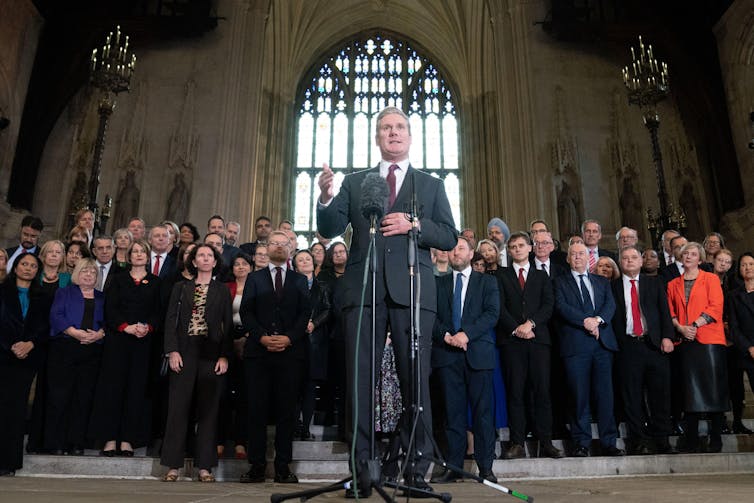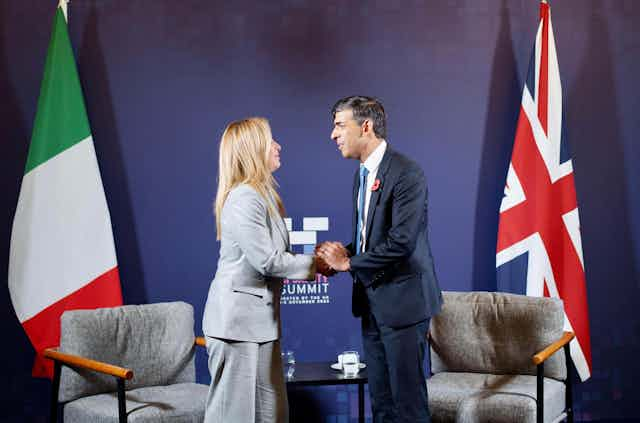Prime Minister Rishi Sunak gave the strongest indication yet that he intends to call the next election for around October 2024 when he released a promotional video asking “What can a country achieve in 52 weeks?” to mark his anniversary of coming to power.
My mathematical model suggests that the time before that election would not be well spent shifting his party further to the right, despite recent signs that this is his intention.
The model also shows that his rival Keir Starmer should avoid shifting to the left if he wants to win.
Pollsters are in the process of releasing information that helps give us a sense of how an election might go. But, crucially, these are a snapshot of what would happen were an election be held tomorrow – not a prediction of a future vote.
The numbers in a poll will, within error margins, determine the vote share of an election if it were held immediately. Translated into probability, in a two-party race, if political party A has 52% support and party B 48%, then the likelihood of party A winning an election held tomorrow is about 100%.
Now, suppose that the election is to take place in a year. What do we learn about the winning probabilities from the numbers 52 and 48 then? For most people, the likelihood of party A winning now seems closer to 52% than 100%.
But what if the election is to take place in two weeks? Or, in three months? To bridge the winning probability today with that on the future election day, we need a mathematical model.
How models work
For a model to be useful in a political context, it should contain at least the following ingredients. First, the results of the current poll. Second, the relative positions taken by different candidates or political parties such as left, centre and right.
Third, when the election is taking place. And fourth, how clearly information about the candidates and their policies are communicated to the electorate.
The way information is communicated is important because politics, after all, is about how politicians communicate with voters. If no information relevant to the political parties and their candidates is given to the electorate in the above example, then after one year, 52% of voters, having not learned anything new about the parties, will still vote for party A.
So, in fact, the winning probability will approach back to 100%. Information is crucial in influencing the outcomes of future elections.
For a two-party race, I have previously worked out a formula for the probability of winning a future election that incorporates these ingredients. The result shows, for instance, that if you are leading the poll today, then it is in your interest not to release any new information. Why rock the boat when you’ve got a comfortable lead?
This helps explain Labour’s current approach of not making many solid commitments and why Boris Johnson minimised his media appearances in the run up to the 2019 election.
Misinformation could cover a shift to the right
When there are three or more political parties, the situation becomes more complicated but also more interesting.
For Sunak, the model advises against more moves to the right if the election is to be held in a year.
The model contains various parameters that need to be calibrated carefully. But let’s assume that the gap in the policy positions within the political spectrum between the Labour and the Liberal Democrats is about the same as that between the Liberal Democrat and the Conservatives (with Labour on the left and the Conservatives on the right).
Let’s also assume that the current poll suggests that Labour is leading the Conservatives by 15 points, which is roughly where polling has stood for some time.
The outcome is that if the Conservatives were to shift their position further to the right, while the other two parties remain where they are, that would only enhance the likelihood of winning the election if the electoral competition is overshadowed by noise such as rumours, speculations, and possibly disinformation.
In other words, when you are lagging behind in the poll, a more extreme position can only be beneficial when it is accompanied by a lot of noise that shifts the public consensus.
This might help explain why we’ve seen bursts of inaccurate information coming from the government lately. Sunak’s false suggestion that he was saving voters from having to use seven recycling bins when no such plan was in motion and that he would scrap a nonexistent meat tax are two examples.
This strategy of confusion would seem like a good idea, according to the model. It’s hard not to note that the only recent byelection win on Sunak’s books lately has been in Uxbridge, where there are credible concerns that misleading information about the local ultra low emission zone fuelled the campaign.
Risky strategies
However, there is a catch. No single political party can control how much information is circulated. So unless the electorate is totally confused by the Conservatives’ information machine and no other party is able to counter its narrative, the strategy will backfire. The model suggests that Conservatives may instead lose by an even wider margin.
For Labour, the model says that leaning further to the left offers nothing but downside. Shifting just slightly to the right, however, would yield some gains – again provided that total confusion does not prevail.
To make Starmer’s stance effective, Labour must prevent confusion and assure transparent messaging. Thus the advice from Labour figures from 1997 that Starmer should make his policy positions clear could not be more apt.

It should be stressed that my mathematical model does not say anything about which policy position or communication strategy is good for the public. It merely tells you how they will affect the winning probabilities.
Sunak has himself emphasised the importance of mathematics education, but perhaps he should start this endeavour with his own political advisers. If nothing else were to change, and even if Sunak were to optimise his communication strategy, the model says he will only enhance his support rate by at most 7%. That’s far from enough to win.

